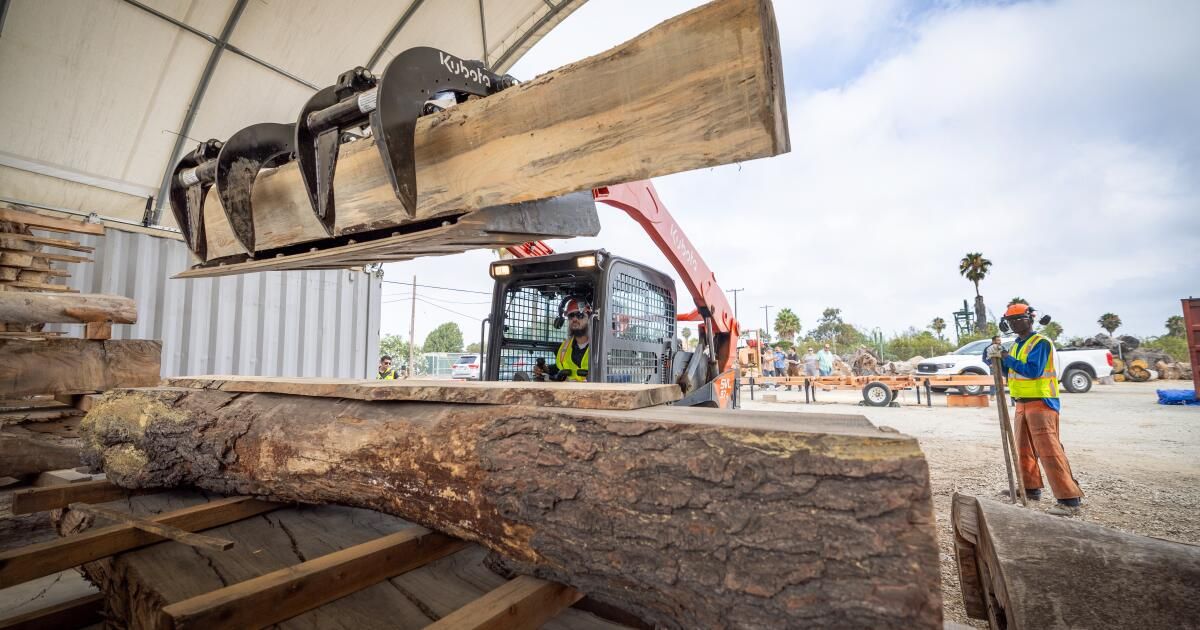To prevent California's 6 million urban trees from knocking down power lines, running over houses or being left lying in the streets when they die, humans have to intervene.
This week, a handful of arborists and members of the Long Beach Conservation Corps gathered on a neglected patch of land in the corner of a city park to do just that.
Early in the morning, corps members used a construction vehicle to grab one of dozens of logs from beneath the shade structure and drop it onto the giant orange wood-milling machine.
Long Beach Conservation Corps worker Pablo De La Garza cuts a large piece of wood at a lumber yard at Willow Springs Park in Long Beach.
(Allen J. Schaben/Los Angeles Times)
“You know what happens, the routine is the same,” Tito Leulusoo, the corps’ personnel supervisor, shouted to the group. “It should be easy. Let’s go for it.”
The saw whistled to life. Corps members slowly and cleanly sliced away the bark on one side of the trunk. This piece of wood, once a thick eucalyptus tree that lived in the city, will one day become a bench, perhaps in one of Long Beach's urban parks.
It is the seed of a vision that the body dreamed of just a few years ago. The body has been planting trees Since its creation in 1987, and now he wants to take care of the trees after they die, turning them into usable wood for houses, desks, benches, sculptures… whatever.
“The only limit is your imagination,” said John Mahoney, urban timber manager at West Coast Arborists. “It’s humanity’s favorite building material, whether you’re looking back or looking forward — it’s the warmth of wood.”
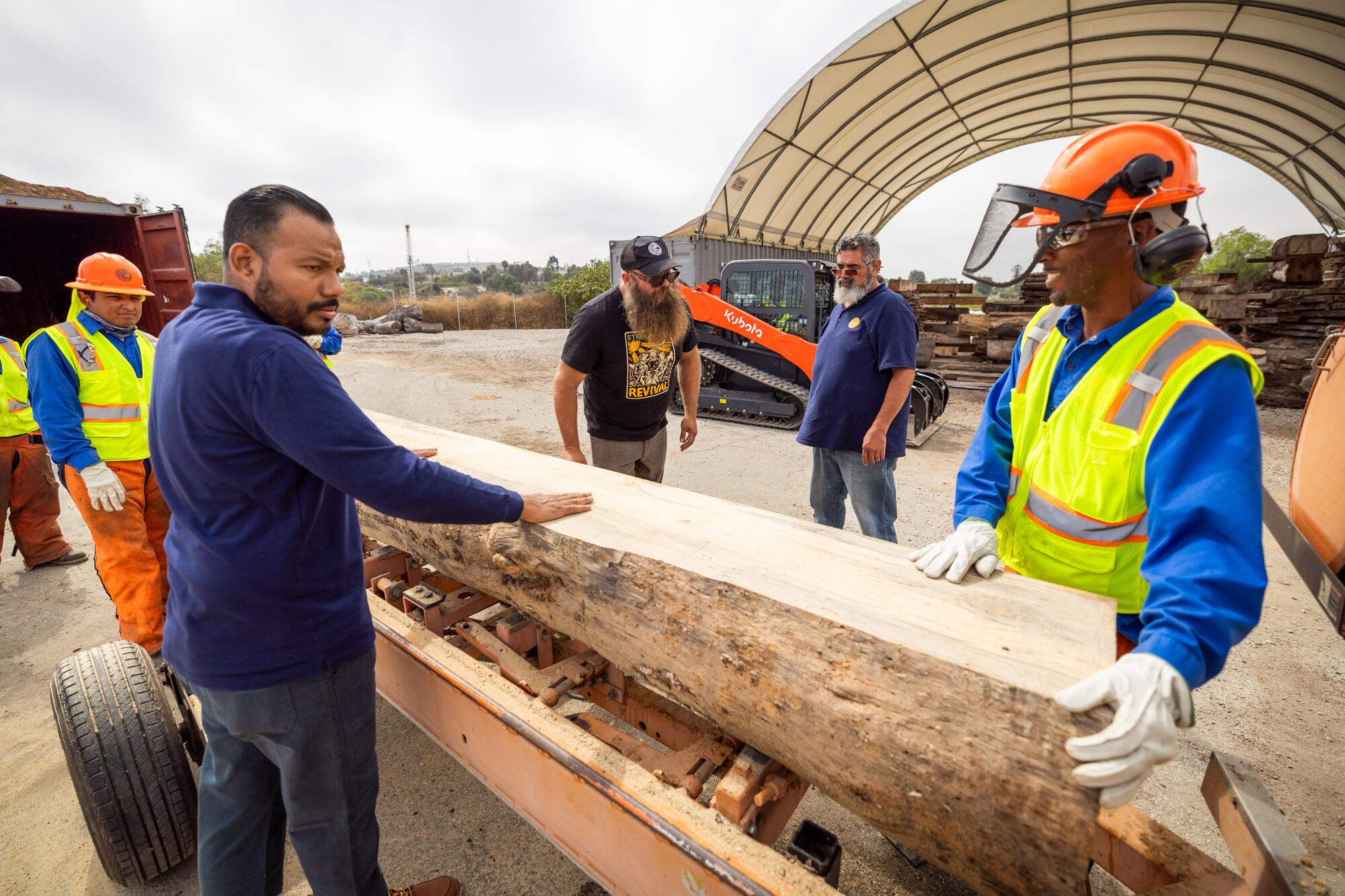
The Long Beach Conservation Corps operates an urban sawmill in a city park. Pictured, from left, are Pablo De La Garza, Javier Valladares, John Mahoney, JJ Ortega and Maurice Lopez at Willow Springs Park in Long Beach.
(Allen J. Schaben/Los Angeles Times)
Dan Knapp, executive director of the Long Beach Conservation Corps, hopes to see the program grow into something much larger. Right now, they're working off and on with some borrowed equipment, but Knapp wants to see a team of corps members dedicated to the project full-time, with their own sawmill and kiln to dry the wood and a store to sell it, all located on the same parcel.
For every tree the body cuts down, it hopes to plant two.
The amount of wood available in cities is not small. Every year, More trees fall More trees are removed from cities than are harvested from national forests, and researchers estimate that urban trees could replace approximately 10% from the United States annual wood consumption.
After the corps secured a $1 million grant from Cal Fire in 2022 to launch the program, the corps immediately turned to one of the state’s longtime leaders in urban timber: West Coast Arborists.
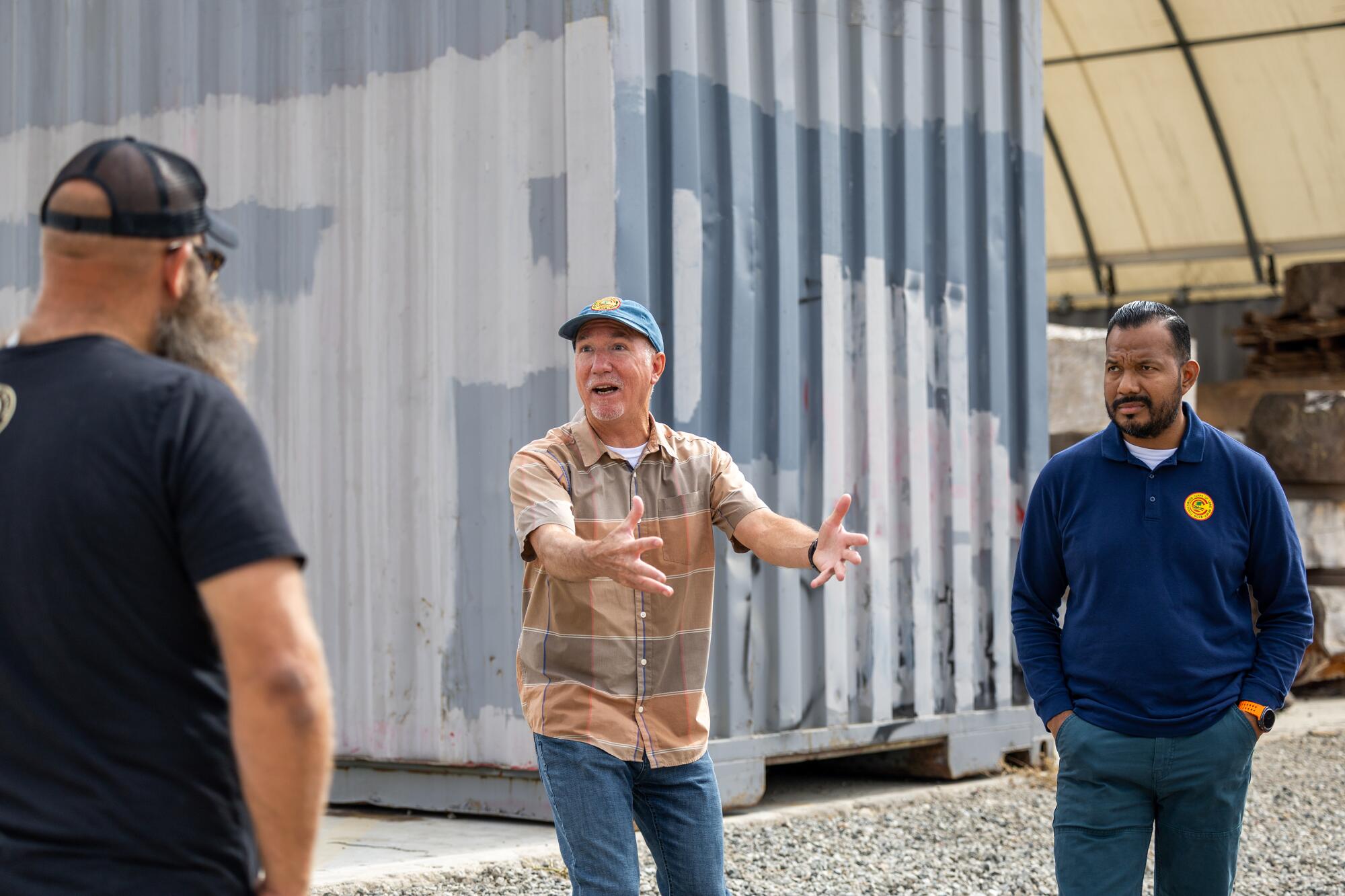
John Mahoney, left, urban timber manager for West Coast Arborists; Dan Knapp, executive director and CEO of the Long Beach Conservation Corps; and Javier Valladares, director of construction training for the Long Beach Conservation Corps, discuss the recent grinding of dead urban trees.
(Allen J. Schaben/Los Angeles Times)
The organization quickly agreed to help the corps. The urban wood resource is vast. “It would be foolish to think we can take it on ourselves,” Mahoney said. “It’s going to take everyone to grow this whole movement… You can save the world as long as you don’t want the credit.”
West Coast arborists say their urban wood has ended up in the homes of A-list celebrities (they are not at liberty to name names), provided acoustic guitar bodies and appeared at the Los Angeles County Fair (as part of the show where A man balances on a log that rolls across a pond.).
“You never know where the wood was grown,” Mahoney said, “but it’s cool for us to think that trees grown in Long Beach are now in Architectural Digest… what the heck, that’s cool.”
Mahoney comes from a family of tree lovers and is packed with fun facts about trees, from how fungi can dye wood any color of the rainbow to the correct way to calculate a tree's age. (Always add five years to the ring count; the first few years are grouped together in the center of the tree, he said.)
During the milling session, Mahoney and a colleague gave advice to the corps members as they worked with the giant milling machine.
For Knapp, the enthusiasm for urban wood is not limited to the environmental benefits alone – it is the opportunity to reach out to young people who are unsure of how to move forward in life and offer them employment and career development opportunities.
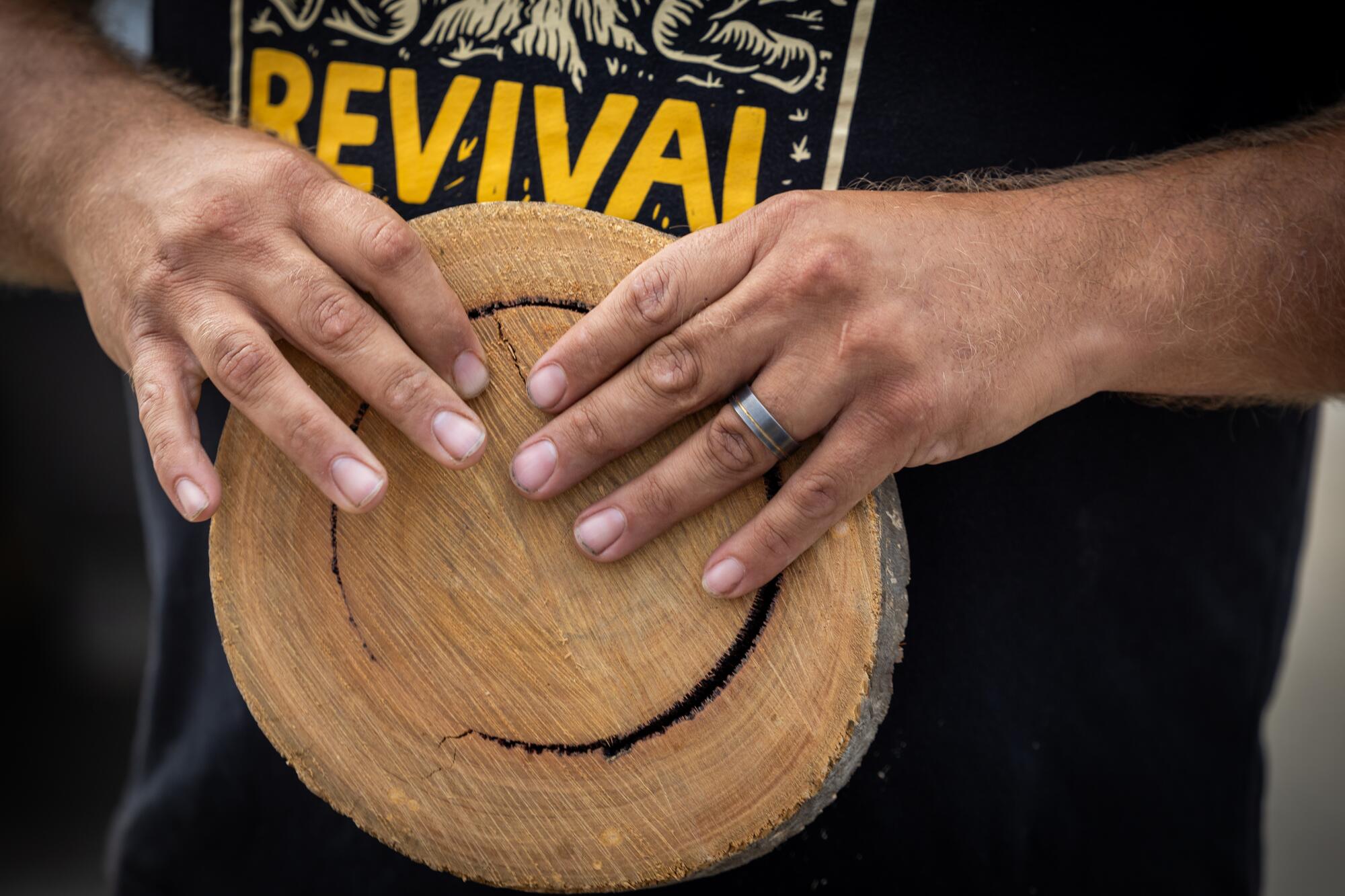
John Mahoney, urban timber manager for West Coast Arborists, holds a piece of wood cut by Long Beach Conservation Corps workers.
(Allen J. Schaben/Los Angeles Times)
“I think we attract young people who are at a key stage in their lives,” Knapp said. “You could be someone who dropped out of high school, someone who was in prison, someone who has all of those characteristics and they come to us.”
The corps offers members opportunities to complete their GED, attend college or vocational school, and meet with employers.
“I was the typical person who went down the wrong path,” Leulusoo said. “The Corps guided me down the right path.”
High school hadn't worked out for Leulusoo, who was born and raised in Long Beach. Some of his family members were in the corps, so he decided to join.
Both Marco Navarrete and Madisen Tanore joined the corps after beginning their college education. They couldn’t ignore the need to get their hands dirty and have a direct impact on their community.
“The Corps allows you to experiment with whatever you want,” said Navarrete, who grew up in Los Angeles. She is studying psychology but hopes to go into project management. “It’s something that will help me here — whether it’s with the Corps or anywhere in Long Beach, really.”
For some of the five corps members who were there, it was their first day at the shipyard. They had come from working on road construction, water irrigation and a variety of other corps projects to spend the day with a hands-on Leulusoo and a wild Mahoney to learn the art of sawing wood.
The corps has even developed a 40-hour training program with West Coast Arborists designed to prepare corps members for entry-level jobs in the field. Knapp's hope is that if they don't end up with a job as West Coast Arborists, they can use their skills in sustainable logging in Southern California's forests, which are becoming overcrowded. flammable vegetation.
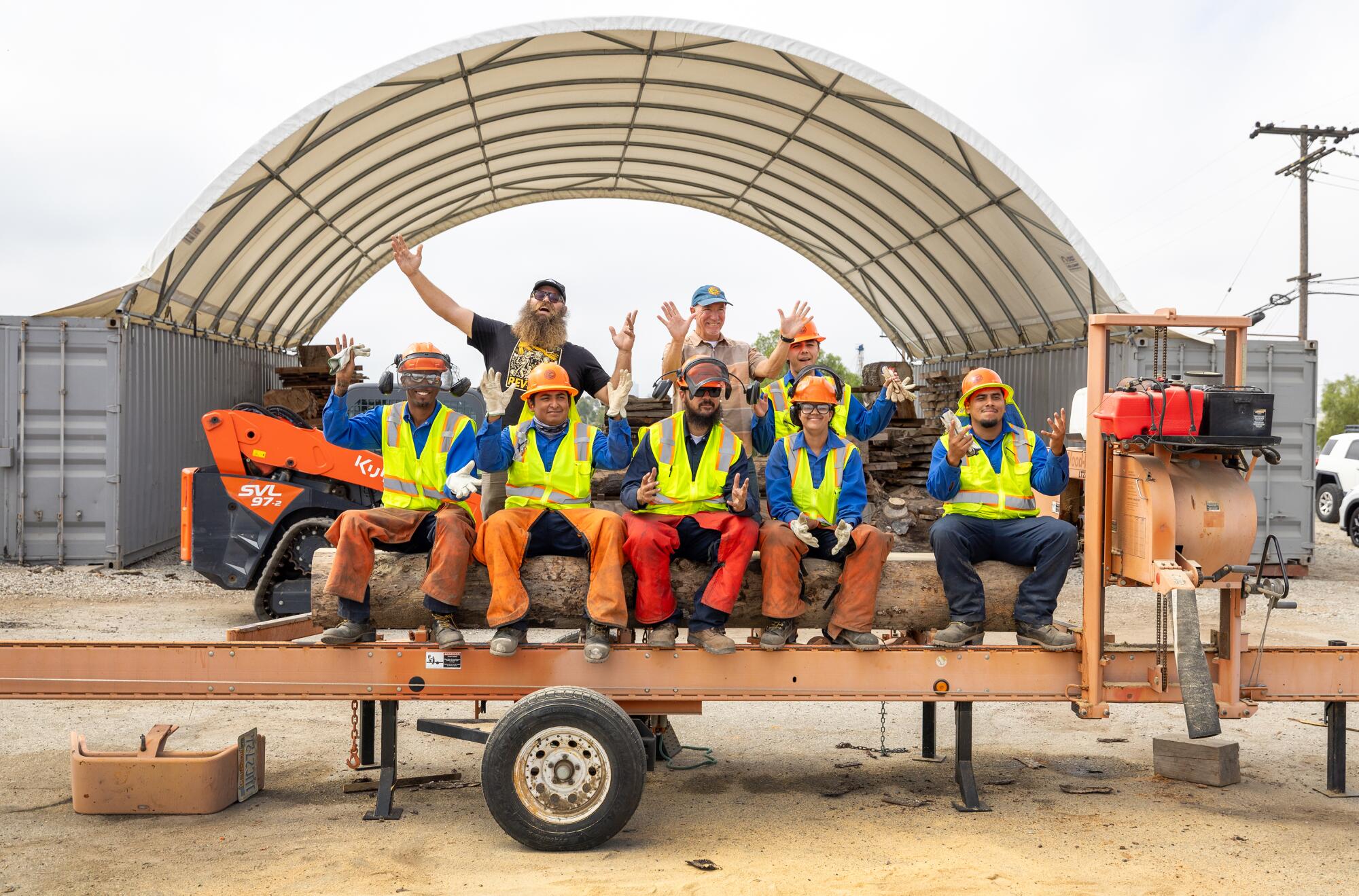
Long Beach Conservation Corps workers pose for a photo during a break from sawing and stacking lumber recently.
(Allen J. Schaben/Los Angeles Times)
Building an urban wood project from scratch is not easy, and if cities want to take advantage of the 10% of wood consumption that urban wood can cover, it is an even more difficult challenge.
First, cities need to know where dying trees are. Lara Roman, an ecological researcher with the Forest Service, said there are two approaches cities can take: proactive and reactive.
“Reactive management is where all you can do is respond to the latest emergency, and in general, in urban forestry, that’s not the ideal system,” Roman said. “The ideal system would be one where you already have an up-to-date inventory and you know where all the trees that are most at risk are.”
An inventory of all the trees in a region allows the city to send crews to clear at-risk trees when a severe storm is approaching or to remove a particular tree species that is susceptible to a pest advancing across the country toward Southern California.
But these inventories are difficult and expensive to conduct and maintain. “Doing a tree inventory is very, very expensive. You have to pay someone to go down every street and measure every tree,” said Natalie Love, who helped compile inventories in a database of 6 million urban trees in California as a researcher at California Polytechnic State University. “It’s a lot of manual labor.”
Even if organizations are aware of a fallen tree, preserving it for wood processing requires extra care, and not all trees are still fit to be used as lumber, especially if they died from disease or pests.
In that case, it is usually shredded into mulch and composted, as California Prohibits residents (including Business and government) of sending dead trees to landfills.
However, this negates one of the key benefits of urban trees: they capture carbon from the atmosphere and store it in their wood.
“Carbon sequestration from urban trees is very short-lived,” Love said. “If a tree lasts 30 years, that means it has 30 years of carbon sequestration, but if the city comes and cuts it down and turns it into wood chips, and then those wood chips rot away, that carbon just goes back into the atmosphere.”
However, if arborists use the cut trees as mulch to support gardens, new trees or other plants, they can still keep carbon out of the air.
“Mulch is fantastic,” Mahoney said, and launched into another fact about trees. “What is the most important end use of a tree?” he said, referring to which end-of-life use sequesters the most carbon. Mulch is second only to wood.with firewood in third place and landfills in last place.
“Am I against mulch? No. Not all trees are good for wood,” Mahoney said. In the case of urban wood, “we’re basically separating the pearls.”
Fact Sheet
Towards a more sustainable California
Receive Boiling Point, our newsletter exploring climate change, energy and the environment, and be part of the conversation – and the solution.
You may occasionally receive promotional content from the Los Angeles Times.

